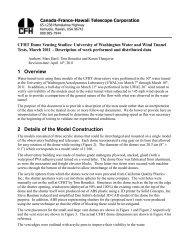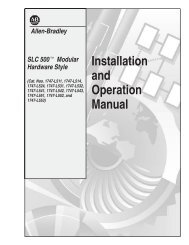Booklet ready version - Canada France Hawaii Telescope ...
Booklet ready version - Canada France Hawaii Telescope ...
Booklet ready version - Canada France Hawaii Telescope ...
Create successful ePaper yourself
Turn your PDF publications into a flip-book with our unique Google optimized e-Paper software.
Finally, the flux in the sky subtracted image is scaled using standard star zeropoint, and chip-to-chip variations<br />
are accounted using the magnitudes of 2Mass objects in each exposure. The astrometric solution and the<br />
zeropoint values are provided as fits header keywords in the detrended, sky subtracted, and astrometrically and<br />
photometrically calibrated image, *p.fits (shown in the green frame in Fig 1).<br />
Figure 2<br />
<br />
face to show the status<br />
of processed<br />
programs, for monitoring<br />
process parameters,<br />
and browsing of<br />
database tables, calibrations<br />
and data<br />
products.<br />
3. Automation and parallel processing<br />
Processing is very flexible, being able to<br />
reduce an entire Camera Run with a single<br />
command, to reducing a particular PI program<br />
crossing multiple camera runs, to reducing a single image.<br />
By incorporating a multi-machine parallel<br />
driver, I’iwi 2 automates and optimizes all<br />
aspects of WIRCam data processing and<br />
calibration for maximum throughput. Computing<br />
resources to use (CPUs, storage<br />
disks, etc) may be easily set based on availability.<br />
Each data product is created in an individual<br />
module (atomically). Modular design permits<br />
the processing to be aborted and restarted<br />
“cleanly” - the pipeline, though running<br />
multiple processes on multiple machines,<br />
may be safely stopped at any time (automatically<br />
cleans up incomplete products and<br />
running processes); when processing resumes,<br />
the pipeline automatically picks up<br />
where it left off.<br />
All processing parameters are taken from a database with a flexible web interface, shown in Fig 2. The interface<br />
permits easy browsing of database tables and processed calibrations, as well as to enable/disable use of<br />
particular data. Processing parameters may be changed as required. Thumbnails of science data product images<br />
are also available for quality evaluation purposes. In addition it is possible to monitor the status and generate<br />
reports of ongoing reductions.<br />
Figure 3a (left)<br />
The relative chip-tochip<br />
offset in photometric<br />
zeropoints<br />
computed with<br />
2MASS catalog.<br />
Figure 3b (right).<br />
The distribution of astrometric<br />
errors along<br />
the chip in second<br />
quadrant. The mosaic<br />
center is the top-left<br />
corner.<br />
4. Photometric and astrometric calibrations<br />
I’iwi 2<br />
computes<br />
photometric<br />
zero<br />
points for<br />
each camera<br />
run instead<br />
of<br />
just once<br />
at the end<br />
of the semester.<br />
Absolute<br />
zero point calibration is obtained using broad and narrow band standard star observations, observed each night<br />
under photometric conditions. Relative zero point offsets between the four CCD chips (Fig 3a) are computed<br />
using 2MASS stars in the standard star fields; we bootstrap available JHK magnitudes from the 2MASS catalog<br />
for the narrow band filters. Celestial coordinates of 2MASS stars in each science image are used for linear<br />
astrometric correction; as a policy, no pixel re-sampling is permitted during data processing. With the current<br />
algorithms, we estimate ~10% error in photometry, and < 2” astrometric error, though with trends across the<br />
mosaic (Fig 3b).<br />
10 2009 & 2010<br />
2009 & 2010 Financial Resources<br />
The three Member Agencies supported the CFHT annual budget<br />
in 2009 and 2010 as shown in the table at the right, in US funds.<br />
These contributions reflect a 3% increase in 2009 over the prior<br />
year, and a 4% increase in 2010 over the prior year, in accordance<br />
with the Golden Age Plan.<br />
Agency Contributions<br />
2009 2010<br />
NRC 3,136,126 3,261,571<br />
CNRS 3,136,126 3,261,571<br />
UH 727,218 756,308<br />
Total 6,999,470 7,279,450<br />
In 2009, under a collaborative agreement with CFHT, the Academia Sinica Institute of Astronomy and<br />
Astrophysics of Taiwan and the Brazilian Ministry of Science and Technology remitted $557,452 and<br />
$180,000, respectively, as reimbursement for costs associated with its use of the Corporation's facilities. Other<br />
sources of funds included $18,072 from mid-level facility use credits, $63,004 from distribution of educational<br />
materials, $63,301 in staffing cost reimbursements related to installation and maintenance of the Mauna Kea<br />
Atmospheric Monitor, and $64,489 in earned interest.<br />
Operating Fund Expenditures<br />
2009 2010<br />
Observatory facilities and<br />
operations<br />
732,435 803,303<br />
Base facilities and<br />
operations<br />
648,639 687,466<br />
Instrumentation 203,284 86,628<br />
Science 66,670 53,601<br />
Outreach 84,956 38,660<br />
General administrative<br />
expenses<br />
356,788 433,133<br />
Staffing 5,041,698 5,101,159<br />
Transfer from Reserve (135,000) 75,500<br />
Total Operating Fund<br />
Expenditures<br />
6,999,470 7,279,450<br />
In 2010, under a collaborative agreement with<br />
CFHT, the Academia Sinica Institute of Astronomy<br />
and Astrophysics of Taiwan and the<br />
Brazilian Ministry of Science and Technology<br />
remitted $437,000 and $418,750, respectively,<br />
as reimbursement for costs associated with its<br />
use of the Corporation's facilities. Other sources<br />
of funds included $13,322 from mid-level<br />
facility use credits, $51,746 from distribution<br />
of educational materials, $39,882 in staffing<br />
cost reimbursements related to installation and<br />
maintenance of the Mauna Kea Atmospheric<br />
Monitor, and $40,221 in earned interest.<br />
From the operating fund, expenditures in 2009<br />
and 2010 were allocated to the areas listed in<br />
the table at left<br />
Overall in 2009 and 2010, resources from all CFHT funds were allocated to the categories of expenditures<br />
shown in the pie chart below.<br />
2.4% 2.1%<br />
1.9%<br />
6.5%<br />
Personnel<br />
26.6%<br />
25.8%<br />
Operating expenses<br />
2009<br />
69.0%<br />
2010<br />
65.7%<br />
Investment in new<br />
developments<br />
Investment in other<br />
assets<br />
CFHT Annual Report 31




![Documentation [PDF] - Canada France Hawaii Telescope ...](https://img.yumpu.com/26965302/1/190x245/documentation-pdf-canada-france-hawaii-telescope-.jpg?quality=85)







